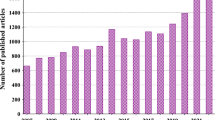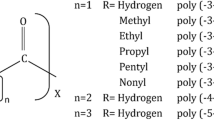Abstract
Biodegradable plastics (BPs) have attracted much attention since more than a decade because they can easily be degraded by microorganisms in the environment. The development of aliphatic-aromatic co-polyesters has combined excellent mechanical properties with biodegradability and an ideal replacement for the conventional nondegradable thermoplastics. The microorganisms degrading these polyesters are widely distributed in various environments. Although various aliphatic, aromatic, and aliphatic-aromatic co-polyester-degrading microorganisms and their enzymes have been studied and characterized, there are still many groups of microorganisms and enzymes with varying properties awaiting various applications. In this review, we have reported some new microorganisms and their enzymes which could degrade various aliphatic, aromatic, as well as aliphatic-aromatic co-polyesters like poly(butylene succinate) (PBS), poly(butylene succinate)-co-(butylene adipate) (PBSA), poly(ε-caprolactone) (PCL), poly(ethylene succinate) (PES), poly(l-lactic acid) (PLA), poly(3-hydroxybutyrate) and poly(3-hydoxybutyrate-co-3-hydroxyvalterate) (PHB/PHBV), poly(ethylene terephthalate) (PET), poly(butylene terephthalate) (PBT), poly(butylene adipate-co-terephthalate (PBAT), poly(butylene succinate-co-terephthalate) (PBST), and poly(butylene succinate/terephthalate/isophthalate)-co-(lactate) (PBSTIL). The mechanism of degradation of aliphatic as well as aliphatic-aromatic co-polyesters has also been discussed. The degradation ability of microorganisms against various polyesters might be useful for the treatment and recycling of biodegradable wastes or bioremediation of the polyester-contaminated environments.





Similar content being viewed by others
References
Acero EH, Ribitsch D, Dellacher A, Zitzenbacher S, Marold A, Steinkellner G, Gruber K, Schwab H, Guebitz GM (2013) Surface engineering of a cutinase from Thermobifida cellulosilytica for improved polyester hydrolysis. Biotechnol Bioeng 110:2581–2590
Akbar S, Hasan F, Nadhman A, Khan S, Shah AA (2013) Purification and characterization of poly (3-hydroxybutyrate-co-3-hydroxyvalerate) degrading enzyme from Streptomyces sp. AF-111. J Poly Environ 21:1109–1116
Akutsu-Shigeno Y, Teeraphatpornchai T, Teamtisong K, Nomura N, Uchiyama H, Nakahara T, Nakajima-Kambe T (2003) Cloning and sequencing of a poly(DL-lactic acid) depolymerase gene from Paenibacillus amylolyticus strain TB-13 and its functional expression in Escherichia coli. Appl Environ Microbiol 69:2498–2504
Baker PJ, Poultney C, Liu Z, Gross R, Montclare JK (2012) Identification and comparison of cutinases for synthetic polyester degradation. Appl Microbiol Biotechnol 93:229–240
Bornscheuer UT (2002) Microbial carboxyl esterases: classification, properties and application in biocatalysis. FEMS Microbiol Rev 26:73–81
Bornscheuer UT, Pohl M (2001) Improved biocatalysts by directed evolution and rational protein design. Curr Opin Chem Biol 5:137–143
Chen Y, Tan L, Chen L, Yang Y, Wang X (2008) Study on biodegradable aromatic/aliphatic copolyesters. Braz J Chem Eng 25:321–335
Eberl A, Heumann S, Kotek R, Kaufmann F, Mitsche S, Cavaco-Paulo A, Gubitz GM (2008) Enzymatic hydrolysis of PTT polymers and oligomers. J Biotechnol 135:45–51
Ghanem NB, Mabrouk ME, Sabry SA, El-Badan DE (2005) Degradation of polyesters by a novel marine Nocardiopsis aegyptia sp. nov.: application of Plackett-Burman experimental design for the improvement of PHB depolymerase activity. J Gen Appl Microbiol 51:151–158
Göpferich A (1996) Mechanisms of polymer degradation and erosion. Biomaterials 17:103–114
Gross RA, Kalra B (2002) Biodegradable polymers for the environment. Science 297:803–807
Hasirci V, Lewandrowski K, Gresser JD, Wise DL, Trantolo DJ (2001) Versatility of biodegradable biopolymers: degradability and an in vivo application. J Biotechnol 86:135–150
Herzog K, Mueller RJ, Deckwer WD (2006) Mechanism and kinetics of the enzymatic hydrolysis of polyester nanoparticles by lipases. Polym Degrad Stab 91:2486–2498
Honda N, Taniguchi I, Miyamoto M, Kimura Y (2003) Reaction mechanism of enzymatic degradation of poly(butylene succinate-co-terephthalate) (PBST) with a lipase originated from Pseudomonas cepacia. Macromol Biosci 3:189–197
Hu X, Thumarat U, Zhang X, Tang M, Kawai F (2010) Diversity of polyester-degrading bacteria in compost and molecular analysis of a thermoactive esterase from Thermobifida alba AHK119. Appl Microbiol Biotechnol 87:771–779
Jendrossek D, Handrick R (2002) Microbial degradation of polyhydroxyalkanoates. Annu Rev Microbiol 56:403–432
Jendrossek D, Muller B, Schlegel HG (1993) Cloning and characterization of the poly(hydroxyalkanoic acid)-depolymerase gene locus, phaZ1, of Pseudomonas lemoignei and its gene product. Eur J Biochem 218:701–710
Jendrossek D, Schirmer A, Schlegel HG (1996) Biodegradation of polyhydroxyalkanoic acids. Appl Microbiol Biotechnol 46:451–463
Kasuya K, Ishii N, Inoue Y, Yazawa K, Tagaya T, Yotsumoto T, Kazahaya J, Nagai D (2009) Characterization of a mesophilic aliphatic-aromatic copolyester-degrading fungus. Polym Degrad Stab 94:1190–1196
Kawai F, Nakadai K, Nishioka E, Nakajima H, Ohara H, Masaki K, Iefuji H (2011) Different enantioselectivity of two types of poly(lactic acid) depolymerases toward poly(L-lactic acid) and poly (D-lactic acid). Polym Degrad Stab 96:132–134
Kawai F, Thumarat U, Kitadokoro K, Waku T, Tada T, Tanaka N, Kawabata T (2013) Comparison of polyester-degrading cutinases from genus Thermobifida. Green Polym Chem: Biocatal Mater II(9):111–120, ACS Symposium Series
Kijchavengkul T, Auras R, Rubino M, Selke S, Ngouajio M, Fernandez RT (2010) Biodegradation and hydrolysis rate of aliphatic aromatic polyester. Polym Degrad Stab 95:2641–2647
Kleeberg I, Welzel K, VandenHeuvel J, Muller RJ, Deckwer WD (2005) Characterization of a new extracellular hydrolase from Thermobifida fusca degrading aliphatic-aromatic copolyesters. Biomacromolecules 6:262–270
Klingbeil B, Kroppenstedt R, Jendrossek D (1996) Taxonomical identification of Streptomyces exfoliatus K10 and characterization of its poly(3-hydroxybutyrate) depolymerase gene. FEMS Microbiol Lett 142:215–221
Li F, Wang S, Liu WF, Chen GJ (2008) Purification and characterization of poly(L-lactic acid)-degrading enzymes from Amycolatopsis orientalis ssp. orientalis. FEMS Microbiol Lett 282:52–58
Li F, Yu D, Lin X, Liu D, Xia H, Chen S (2012) Biodegradation of poly(e-caprolactone) (PCL) by a new Penicillium oxalicum strain DSYD05-1. World J Microbiol Biotechnol 28:2929–2935
Lucas N, Bieniame C, Belloy C, Queneudec M, Silvestre F, Nava-Saucedo JE (2008) Polymer biodegradation: mechanisms and estimation techniques. Chemosphere 73:429–442
Mabrouk MM, Sabry SA (2001) Degradation of poly (3-hydroxybutyrate) and its copolymer poly (3-hydroxybutyrate-co-3-hydroxyvalerate) by a marine Streptomyces sp. SNG9. Microbiol Res 156:323–335
Maeda H, Yamagata Y, Abe K, Hasegawa F, Machida M, Ishioka R, Gomi K, Nakajima T (2005) Purification and characterization of a biodegradable plastic-degrading enzyme from Aspergillus oryzae. Appl Microbiol Biotechnol 67:778–788
Marten E, Mueller RJ, Deckwer WD (2005) Studies on enzymatic hydrolysis of polyesters. II. Aliphatic-aromatic co-polyesters. Polym Degrad Stab 88:371–381
Masaki K, Kamini NR, Ikeda H, Iefuji H (2005) Cutinase-like enzyme from the yeast Cryptococcus sp. strain S-2 hydrolyzes polylactic acid and other biodegradable plastics. Appl Environ Microbiol 71:7548–7550
Mergaert J, Webb A, Anderson C, Wouters A, Swings J (1993) Microbial degradation of poly(3-hydroxybutyrate) and poly(3-hydroxybutyrateco-3-hydroxyvalerate) in soils. Appl Environ Microbiol 59:3233–3238
Molitoris HP, Moss ST, deKoning GJM, Jendrossek D (1996) Scanning electron microscopy of polyhydroxyalkanoate degradation by bacteria. Appl Microbiol Biotech 46:570–579
Mueller RJ (2006) Biological degradation of synthetic polyesters-enzymes as potential catalysts for polyester recycling. Proc Biochem 41:2124–2128
Mueller RJ, Witt U, Kleeberg I, Abou-Zeid DM, Marten E, Herzog K, Sieblitz D, Dresler K, Deckwer WD (2007) Mechanism of polyester degradation by enzymes. Polym Prep 48:599–600
Muller B, Jendrossek D (1993) Purification and properties of poly(3-hydroxyvaleric acid) depolymerase from Pseudomonas lemoignei. Appl Microbiol Biotechnol 38:487–492
Nadhman A, Hasan F, Shah Z, Hameed A, Shah AA (2012) Production of poly(3-hydroxybutyrate-co-3-hydroxyvalerate) depolymerase from Aspergillus sp. NA-25. Appl Biochem Microbiol 48:482–487
Nakajima-Kambe T, Ichihashi F, Matsuzoe R, Kato S, Shintani N (2009a) Degradation of aliphatic-aromatic co-polyesters by bacteria that can degrade aliphatic polyesters. Polym Degrad Stab 94:1901–1905
Nakajima-Kambe T, Toyoshima K, Saito C, Takaguchi H, Akutsu-Shigeno Y, Sato M, Miyama K, Nomura N, Uchiyama H (2009b) Rapid monomerization of poly(butylene succinate)-co-(butylene adipate) by Leptothrix sp. J Biosci Bioeng 108:513–516
Narayan R (2001) Drivers for biodegradable/compostable plastics & role of composting waste management & sustainable agriculture. In: ORBIT 2001 Conference. Seville, Spain: Spanish waste club; 2001
Ohtaki S, Maeda H, Takahashi T, Yamagata Y, Hasegawa F, Gomi K, Nakajima T, Abe K (2006) Novel hydrophobic surface binding protein, HsbA, produced by Aspergillus oryzae. Appl Environ Microbiol 72:2407–2413
Rhee J, Ahn D, Kim Y, Oh J (2005) New thermophilic and thermostable esterase with sequence similarity to the hormone-sensitive lipase family, cloned from a metagenomic library. Appl Environ Microbiol 71:817–825
Russell JR, Huang J, Anand P, Kucera K, Sandoval AG, Dantzler KW, Hickman DS, Jee J, Kimovec FM, Koppstein D, Marks DH, Mittermiller PA, Núñez SJ, Santiago M, Townes MA, Vishnevetsky M, Williams NE, Vargas MPN, Boulanger LA, Slack CB, Strobel SA (2011) Biodegradation of polyester polyurethane by endophytic fungi. Appl Environ Microbiol 77:6076–6084
Santos M, Gangoiti J, Keul H, Moller M, Serra JL, Llama MJ (2013) Polyester hydrolytic and synthetic activity catalyzed by the medium-chain-length poly(3-hydroxyalkanoate) depolymerase from Streptomyces venezuelae SO1. Appl Microbiol Biotechnol 97:211–222
Scharathow R (2009) BIOPLASTICS: the framework for market introduction in Europe, Presented at the 2nd International Science and Technology Conference, “The Future of Biodegradable Packaging”, Warsaw, Poland, Sept 29. COBRO, Warsaw, pp 34–52
Schirmer A, Jendrossek D, Schlegel HG (1993) Degradation of poly(3-hydroxyoctanoic acid) [P(3HO)] by bacteria: purification and properties of a P(3HO) depolymerase from Pseudomonas fluorescens GK13. Appl Environ Microbiol 59:1220–1227
Schober U, Thiel C, Jendrossek D (2000) Poly(3-hydroxyvalerate) depolymerase of Pseudomonas lemoigne. Appl Environ Microbiol 66:1385–1392
Seo HS, Um HJ, Min J, Rhee SK, Cho TJ, Kim YH, Lee J (2007) Pseudozyma jejuensis sp. nov., a novel cutinolytic ustilaginomycetous yeast species that is able to degrade plastic waste. FEMS Yeast Res 7:1035–1045
Shah AA, Hasan F, Hameed A, Ahmed S (2007) Isolation and characterization of poly (3-hydroxybutyrate-co-3-hydroxyvalerate) degrading bacteria and purification of PHBV depolymerase from newly isolated Bacillus sp. AF3. Int Biodeterior Biodegrad 60:109–115
Shah AA, Hasan F, Hameed A (2010) Degradation of poly(3-hydroxybutyrate-co-3-hydroxyvalerate) by a newly isolated Actinomadura sp. AF-555 from soil. Int Biodeterior Biodegrad 64:281–285
Shah AA, Eguchi T, Mayumi D, Kato S, Shintani N, Kamini NR, Nakajima-Kambe T (2013a) Purification and properties of novel aliphatic-aromatic co-polyesters degrading enzymes from newly isolated Roseateles depolymerans strain TB-87. Polym Degrad Stab 98:609–618
Shah AA, Eguchi T, Mayumi D, Kato S, Shintani N, Kamini NR, Nakajima-Kambe T (2013b) Degradation of aliphatic and aliphatic-aromatic co-polyesters by depolymerases from Roseateles depolymerans strain TB-87 and analysis of degradation products by LC-MS. Polym Degrad Stab 98:2722–2729, Available online
Shalaby WSW, Park K (1994) Chemical modification of proteins and polysaccharides and its effect on enzyme-catalyzed degradation, in Biomedical polymers. In: Shalaby SW (ed) Designed-to-degrade systems. Hanser Publishers, Munich, chap. 9
Shinozaki Y, Morita T, Cao XH, Yoshida S, Koitabashi M, Watanabe T, Suzuki K, Sameshima-Yamashita Y, Nakajima-Kambe T, Fujii T, Kitamoto HK (2013) Biodegradable plastic-degrading enzyme from Pseudozyma antarctica: cloning, sequencing, and characterization. Appl Microbiol Biotechnol 97:2951–2959
Song JH, Murphy RJ, Narayan R, Davies GBH (2009) Biodegradable and compostable alternatives to conventional plastics. Philos Trans R Soc Lond B Biol Sci 364:2127–2139
Tan FT, Cooper DG, Marić M, Nicell JA (2008) Biodegradation of a synthetic co-polyester by aerobic mesophilic microorganisms. Polym Degrad Stab 93:1479–1485
Tribedi P, Sarkar S, Mukherjee K, Sil AK (2012) Isolation of a novel Pseudomonas sp from soil that can efficiently degrade polyethylene succinate. Environ Sci Pollut Res 19:2115–2124
Tseng CL, Chen HJ, Shaw GC (2006) Identification and characterization of the Bacillus thuringiensis phaZ Gene, encoding new intracellular poly-3-hydroxybutyrate depolymerase. J Bacteriol 188:7592–7599
Upreti MC, Srivastava RB (2003) A potential Aspergillus species for biodegradation of polymeric materials. Curr Sci 84:1399–1402
Williams DF, Zhong SP (1994) Biodeterioration/biodegradation of polymeric medical devices in situ. Int Biodeterior Biodegrad 34:95–130
Witt U, Einig T, Yamamoto M, Kleeberg I, Deckwer WD, Muller RJ (2001) Biodegradation of aliphatic–aromatic copolyesters: evaluation of the final biodegradability and ecotoxicological impact of degradation intermediates. Chemosphere 44:289–299
Author information
Authors and Affiliations
Corresponding author
Rights and permissions
About this article
Cite this article
Shah, A.A., Kato, S., Shintani, N. et al. Microbial degradation of aliphatic and aliphatic-aromatic co-polyesters. Appl Microbiol Biotechnol 98, 3437–3447 (2014). https://doi.org/10.1007/s00253-014-5558-1
Received:
Revised:
Accepted:
Published:
Issue Date:
DOI: https://doi.org/10.1007/s00253-014-5558-1




